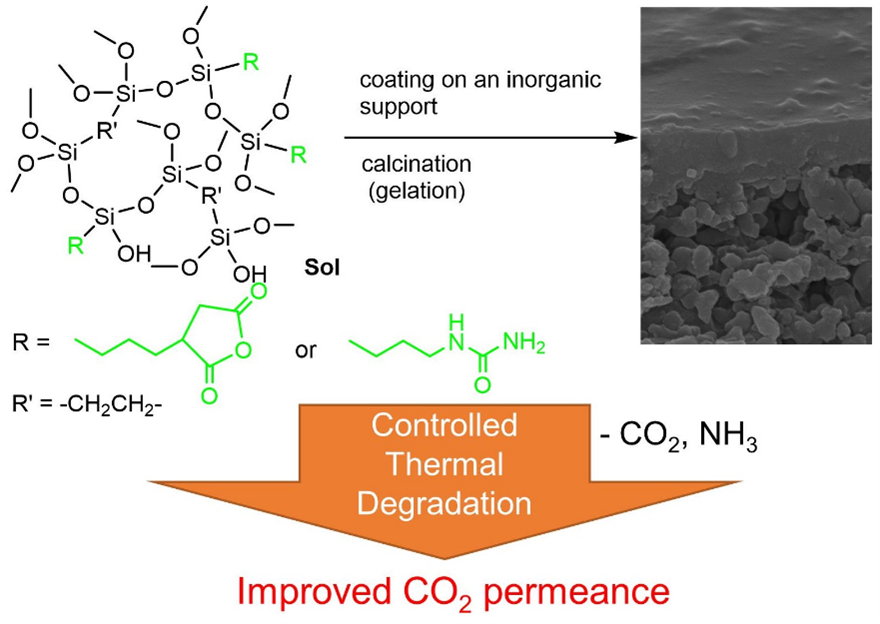研究概要
元素によるπ電子系の電子状態制御
様々な元素の電子的あるいは構造的な特徴を活かして、全く新しい骨格の有機材料を構築することができれば、新たな機能を引き出せる可能性を秘めています。私たちは、画期的な分子設計指針に基づいて、有機材料の特性・機能を自在に制御することで、次世代の機能性有機材料の創製を目指しています。例えば、3配位のホウ素は、空のp軌道を有し、隣接するπ軌道とp-π相互作用をすることで電子受容性を大幅に向上できます。また、その構造上の剛直性は、環状構造をとった場合のコンフォメーション制御に利用できるため、新たな刺激応答性クロミック材料への展開も可能になります。似たように、14族重原子のケイ素、ゲルマニウムでは、空間的に広がっているσ*軌道を利用することができ、15族のビスマスでは、重原子効果によるりん光発光性の向上などが期待できます。このような元素を効果的に利用した戦略で、有機光電子デバイスなどに利用できる新しいタイプの機能性色素の開発を行っています。
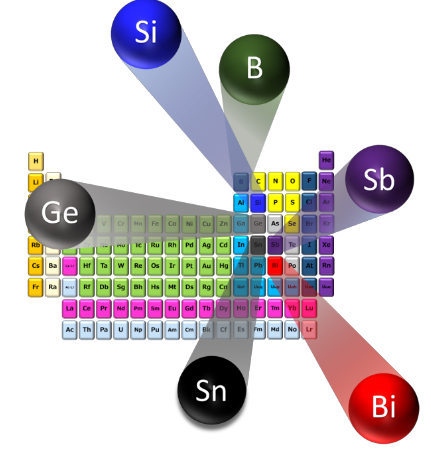
ポリシルセスキオキサンの新展開
ポリシルセスキオキサンは、無機材料のシリカの各ケイ素上に一つの有機基を導入した構造を持つもので、有機-無機ハイブリッド材料の代表例として多くの研究がなされてきました。われわれは、有機材料の加工性、柔軟性などと無機材料の堅牢性を兼ね備えたポリシルセスキオキサンの特徴を利用して、ロバストな水分離膜、炭酸ガス分離膜、防曇材料、断熱材料の開発研究を進めています。
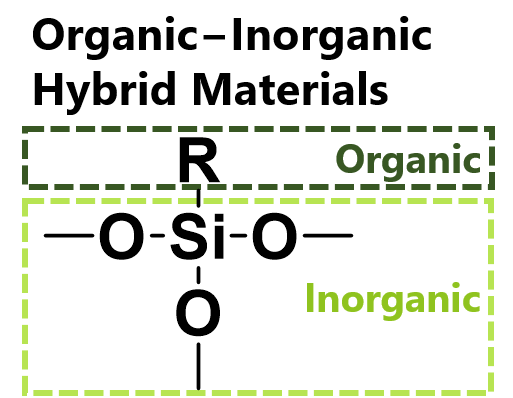
Research Topics
Effects of aryl substituents on the performance of PSQ-based CO2 separation membranes
New PSQ-based membranes were prepared using trialkoxysilane precursors with phenyl, pyridyl, and naphthyl substituents, and their CO2 separation performance was evaluated. Among them, the pyridyl-containing membrane exhibited the highest permeance, with a CO2 permeance of 997 GPU and CO2/N2 permselectivity of 16.5. DFT calculations were performed to understand the effects of aryl substituents on CO2 separation performance.
For details, see: 10.1007/s10971-025-06904-4

PSQ-based Antifogging Coating Materials with Tetraethylene Glycol Chains and Amine Hydrochloride Salts
This study investigated the effects of incorporating tetraethylene glycol chains and amine hydrochloride salts into amino-functionalized polysilsesquioxane (PSQ) films for antifogging applications. We found that incorporating tetraethylene glycol chains and amine hydrochloride salts into amino-functionalized PSQs improves transparency, surface morphology, and reduction in WU changes against humidity fluctuations. These findings highlight the potential of ammonium- and tetraethylene glycol-modified PSQ films as high-performance antifogging materials with superior hydrophilicity, transparency, and reduction in WU against humidity fluctuations.
For details, see:10.1021/acsaenm.5c00168

ML for Fluorescent Metalloles
Organic luminescent compounds have been extensively studied for applications in imaging, sensing, and electroluminescent materials. In this study, we developed a machine learning-based prediction model for the fluorescence quantum yields of metalloles, being useful for the screening of novel fluorescent material candidates.
For details, see:10.3390/molecules30081686

Quaternary Ammonium-functionalized PSQs for Antifogging Coating
To develop antifogging materials with improved antifogging properties and scratch resistance, polysilsesquioxane films containing quaternary ammonium groups were prepared through a sol–gel reaction of [4-(chloromethyl)phenyl]triethoxysilane followed by quaternization. These quaternary ammonium-functionalized polysilsesquioxane films exhibit high water uptake, scratch hardness, and transparency, making them promising candidates for antifogging coatings.
For details, see: 10.1039/D4LP00322E
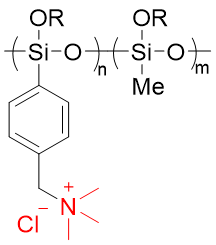
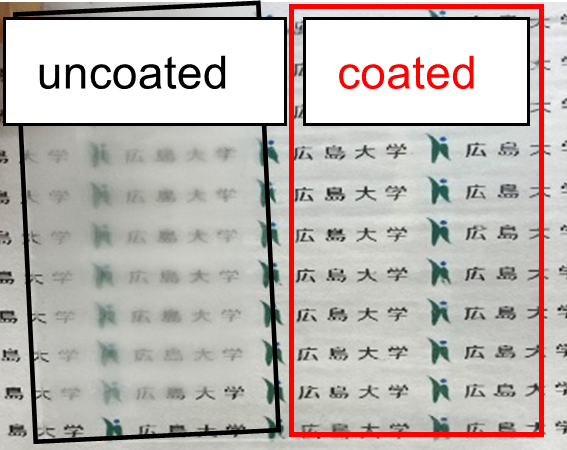
Thiophene-fused Bistricyclic Aromatic Enes
Bistricyclic aromatic enes (BAEs) are compounds consisting of two tricyclic structures linked by a C=C double bond, and they can adopt multiple conformational isomers such as twisted and anti-folded conformers. We have found that by fusing thiophene rings to the BAE framework, it is possible to control the energy of these conformational isomers. For example, BAEs containing carbonyl units stabilize in the twisted conformer and function as n-type semiconductors. We have also demonstrated that the thermodynamic stability of conformers of BAEs can be precisely controlled by introducing various heteroatoms.
For details, see: 10.1039/D4CC02943G / 10.1002/chem.202302370 / 10.1039/D4SC06150K
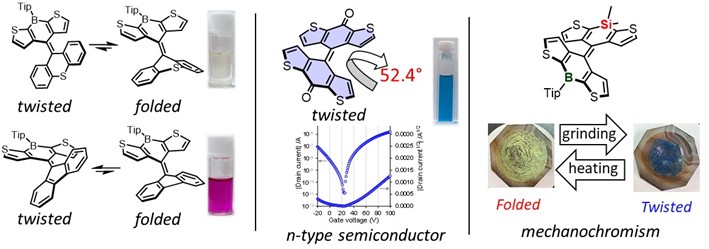
Boron-based Photoluminescent Materials
Solid-state luminescent materials are critical for a wide range of applications, including organic light-emitting diodes (OLEDs), data storage devices, and security inks. Among emissions, phosphorescence, which is emission from an excited triplet state, has a long lifetime and is particularly important in the fields of OLEDs and bioimaging. Phosphorescence is generally efficiently emitted only from materials containing precious and heavy metals such as iridium and platinum. We have developed a phosphorescent material free of any heavy metals, consisting of a compound called borepin. This compound features a boron-containing, unsaturated seven-membered ring fused with thiophene rings. In its crystalline state, it exhibits red phosphorescence, and we revealed that its photoluminescence properties are significantly influenced by the non-planar structure of borepin and the aryl group attached to the boron atom.
For details, see: 10.1039/D4SC01184H
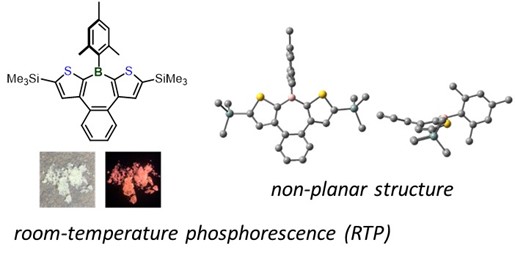
PSQ-based Heat-resistant Thermal Insulators
Heat insulators are key materials for efficient energy use and reduction of CO2 emissions. Recently, we examined cross-linked polymethylsilsesquioxane (MSQ) for use as the basic structure of heat-resistant insulation materials. In this study, we prepared MSQs with different cross-linking units and examined the effects of their structures on the heat resistance and heat insulation properties.
For details, see: 10.1038/s41428-024-00953-2

Unsymmetrical Dithienogermole as a New Electron Donor Unit
Group 14 metalloles have attracted much attention as core structures of conjugated functional materials. In this work, we prepared dithieno[3,2-b:4,5-c’]germole as a new unsymmetrically condensed dithienogermole. Conjugated donor–acceptor compounds with the unsymmetrical dithienogermole exhibiting red fluorescence were also prepared.
For details, see: 10.3390/molecules29153553
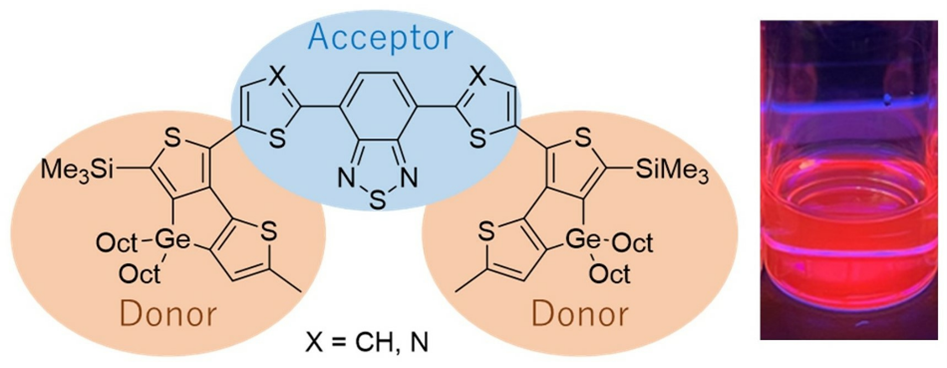
Thienotriazologermole as a New Electron Acceptor Unit for D-A Systems
Germoles and siloles unsymmetrically condensed with heteroaromatic units are attracting much interest. In this study, compounds containing a triazologermole core unit condensed with a benzene or thiophene ring were prepared. Triphenylamine-substituted thienotriazolegermole was also prepared, with an effective extension of conjugation. Triphenylamine-substituted thienotriazolegermole showed clear solvatochromic properties in photoluminescence measurements, suggesting photo-induced intramolecular charge transfer.
For details, see: 10.3390/molecules29112684
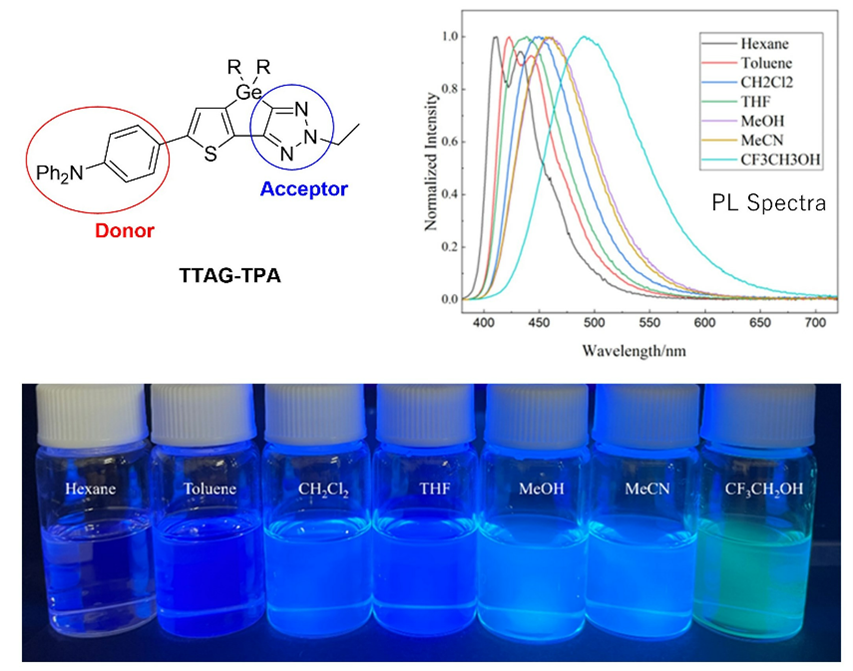
PSQ-based CO2 Separation Membranes
New polysilsesquioxane (PSQ)-based CO2 separation membranes with succinic anhydride and monoalkylurea units as thermally degradable CO2-philic units were prepared. The succinic anhydride and monoalkylurea units underwent thermal degradation to form ester and dialkylurea units. The effects of thermal degradation on the performance of the obtained membranes were investigated, indicating that the controlled thermal degradation of the organic units provides a new methodology for possible tuning of the CO2 separation performance of PSQ membranes.
For details, see: 10.3390/separations11040110
